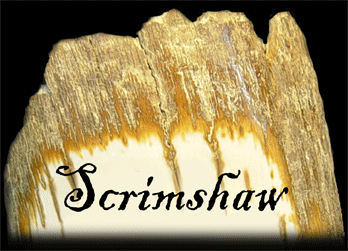

" Where Your Art Matters "
Artist Owned and Operated since 1996

Charles W. Conner III
Master Color Artist

Scrimshaw is derived from the shipboard practice of sailors creating common tools,
and on whaling ships the byproducts of whales were readily available. The term
originally referred to the making of these tools, only later referring to works of art
created by whalers in their spare time. Whale bone is ideally suited for the task.
The development of scrimshaw took off after the market for whale teeth, which
was sought by Chinese traders for use in the Pacific Islands (for example the Fijian
market for tabua), was flooded with teeth after a narrative by an American sailor,
Captain David Porter, revealed both the market and the source of the teeth.
Around this time is the earliest authenticated pictorial piece of scrimshaw (1817).
The tooth was inscribed with the following: This is the tooth of a sperm whale
that was caught near the Galapagos islands by the crew of the ship Adam [of London],
and made 100 barrels of oil in the year 1817.
Other sea animal ivories were also used as alternatives for rarer whale teeth.
Walrus tusks, for example, may have been acquired in trade from indigenous walrus
hunters.
Scrimshaw essentially was a leisure activity for whalers. Because the work of whaling
was very dangerous at the best of times, whalers were unable to work at night. This
gave them a great deal more free time than other sailors. A lot of scrimshaw was never
signed and a great many of the pieces are anonymous. Early scrimshaw was done with
crude sailing needles, and the movement of the ship, as well as the skill of the artist,
produced drawings of varying levels of detail and artistry. Originally, candle black,
soot or tobacco juice would have been used to bring the etched design into view.
Today's artists use finer tools in various sizes, mostly borrowed from the dental industry.
Some scrimshanders ink their work with more than one color, and restrained polychromed
examples of this art are now popular.
-
Though there are sources of ivory that are sanctioned and legal, poachers in Africa
and other continents where elephants are an endangered species still kill for their
ivory, Elephant ivory has been regulated since 1976 by the Convention on International
Trade in Endangered Species and selling African ivory has been prohibited since 1989. -
19th and 20th century scrimshaw, scrimshaw crafted before 1989 (elephant) or before
1973 (sperm whale ivory, walrus ivory etc.) is legal. It is prohibited after that year for
commercial import in the U.S. under the Marine Mammal Protection Act. -
Additionally, walrus tusks bearing the Alaska State walrus ivory registration tag, and
post-law walrus ivory that has been carved or scrimshawed by a native Alaskan Indian
(Eskimo), is legally available. -
Finally, any ivory considered ancient, such as 10,000 to 40,000 year old mammoth ivory,
is completely unrestricted in its sale or possession.

